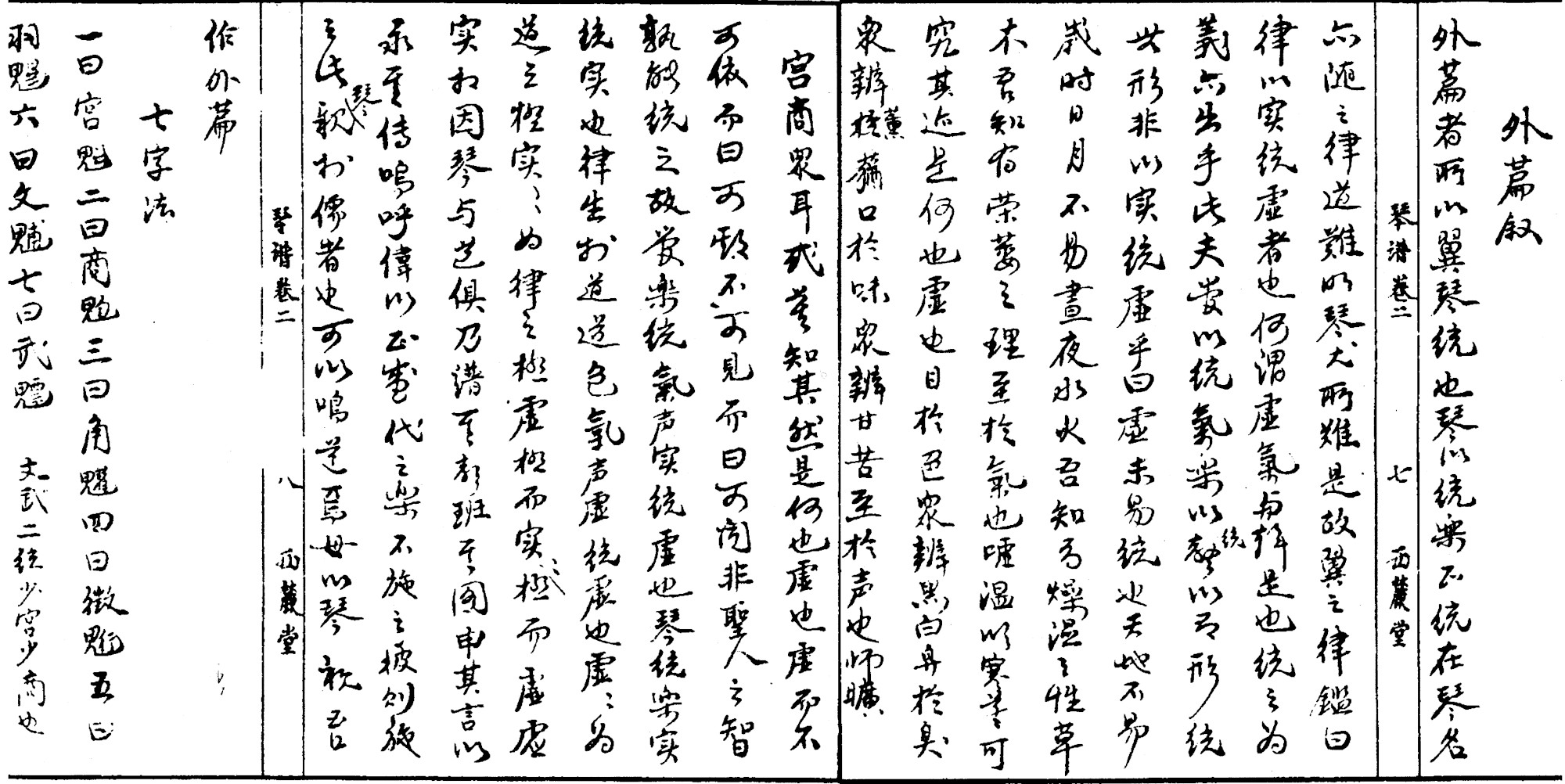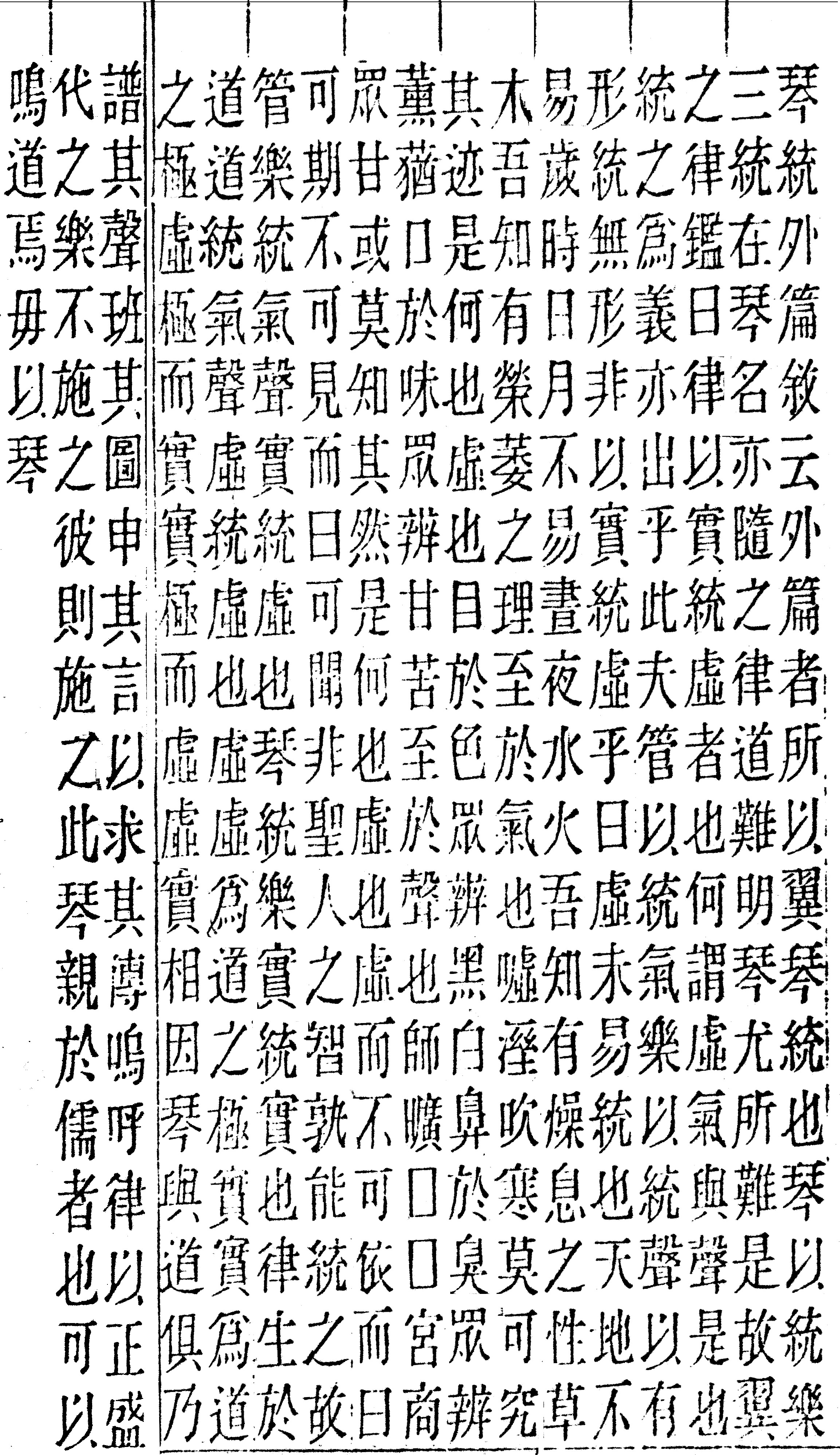|
T of C
Home |
My Work |
Hand- books |
Qin as Object |
Qin in Art |
Poetry / Song |
Hear, Watch |
Play Qin |
Analysis | History |
Ideo- logy |
Miscel- lanea |
More Info |
Personal | email me search me |
| XLTQT Original ToC Comments Tunings Zha preface Tang Gao preface Wang Zhi preface Pursuing antiquity | 首頁 |
|
Preface to Further Essays
1
from Xilutang Qintong (1525; QQJC III/27-28) |
外篇叙
作者:汪芝 |
| Original text from QQJC III/27-28; enlarge |
 This essay, like Pursuing Antiquity, was also copied into Qinshu Cunmu, where it is also attributed to
Xu Li, original author of the Qin Tong (see further).
This essay, like Pursuing Antiquity, was also copied into Qinshu Cunmu, where it is also attributed to
Xu Li, original author of the Qin Tong (see further).
These further essays serve to supplement the Qin Tong.
Proper unifying principles reside in the qin, and so terms follow accordingly.
The principles of tuning are hard to grasp; those for the qin are among the hardest. Thus, I have supplemented the above with a "mirror on modality", which says the following:
外篇者,所以翼《琴統》也。琴以統樂,正統在琴,名亦隨之。 律道難明,琴尤所難。是故翼之律鑑,曰:
Tuning is the use of something concrete to regulate something abstract. What is meant by "abstract"? It is breath and sound. The idea of "governing" (統, tong) also arises from this. The pitch-pipe system governs breath (qi); music governs sound — this is the tangible governing the intangible. Is this not, then, the concrete governing the abstract?
「律以實統虛者也。」何謂虛?氣與聲是也。 統之為義,亦出乎。此夫樂以統氣,樂以統聲,以有形統無形, 非以實統虛乎?
Response: the abstract is not easily governed. Heaven and Earth do not change. The seasons, sun and moon, day and night, water and fire — these I know to possess innate natures of dryness and dampness, heat and cold. Grasses and trees - these I know follow the patterns of blooming and withering. But as for qi, it exhales warmth but blows cold, yet its traces cannot be followed. Why is this so? Because it is abstract.
曰:虛未易統也。 天地不易,歲時、日月不易;晝夜、水火,吾知有燥濕之性;草木吾知有榮萎之理。 至於氣也,噓溫吹寒,莫可究其跡,是何也?虛也!
The eyes perceive color — people can distinguish black from white. The nose perceives scent — people can distinguish fragrance from stench. The mouth perceives taste — people can distinguish sweet from bitter. But with sound — even Master Kuang could distinguish the musical modes, yet most listeners do not know how this is so. Why? Because it is abstract. The abstract cannot be relied on, yet people say it can produce sound; it cannot be seen, yet they say it can be heard. Without the wisdom of a sage, who could govern it?
目於色,眾辨黑白;鼻於臭,眾辨薰蕕;口於味,眾辨甘苦。 至於聲也,師曠辨能辨宮商,眾耳或莫知其然是何也?虛也。 虛而不可依,而曰可聲;不可見,而曰可聞。非聖人之智,孰能統之?
Therefore: Pitch-pipes and musical instruments govern qi and sound — the concrete governing the abstract. The qin governs music — the concrete governing the concrete. Tuning arises from the Dao; the Dao governs qi and sound — the abstract governing the abstract. When the abstract governs the abstract, that is the highest expression of Dao. When the concrete governs the concrete, that is the highest expression of pitch (律). When the abstract reaches its extreme, it gives rise to the concrete; when the concrete reaches its extreme, it returns to the abstract. The abstract and the concrete mutually depend.
故, 管樂統氣聲,實統虛也; 琴統樂,實統實也。 律生於道,道色氣、聲,虛統虛也。 虛統虛為道之極; 實統實為律之極。 虛極而實, 實極而虛, 虛實相因。
The qin aligns with the Dao. Thus I notate its sounds, arrange its diagrams, clarify is principles, and seek its transmission.
琴與道俱,乃譜其聲,班其圖,申其言,以永其傳。
Alas! If you praise using orthodox sounds to represent music, but instead of applying (these standards) there (to orthodox music) you instead use them here (i.e., to qin music), then since the qin is so intimate with the Confucian way, its sound will then be able to resound with the Dao. And yet you don't use the qin (in this way)?
鳴呼! 偉以正盛代之樂,不施之彼,則施之此,琴親於儒者也,可以鳴道焉。毋以琴?
視吾作外篇。
Footnotes (Shorthand references are explained on a
separate page)
| 1. Preface to Further Essays (外篇叙 Waipian Xu; QQJC III/27-28) | Qinshu Cunmu version |
 The above Chinese text was done originally with OCR, then corrected as much as possible first with assistance from the version at right copied from
Qinshu Cunmu#112/b, then with assistance from Peiyou Chang, who has translated several Xilutang Qinpu essays on her website
(peiyouqin.com).
The above Chinese text was done originally with OCR, then corrected as much as possible first with assistance from the version at right copied from
Qinshu Cunmu#112/b, then with assistance from Peiyou Chang, who has translated several Xilutang Qinpu essays on her website
(peiyouqin.com).
The punctuation and translation were originally done by Chat GPT. I have tried to correct that as much as possible, but cannot say I completely understand it. Qinshu Cunmu says its copy is from the Qin Tong of Xu Li.
Some terms are questioned.
(Return)
Return to top, or to the Guqin ToC.